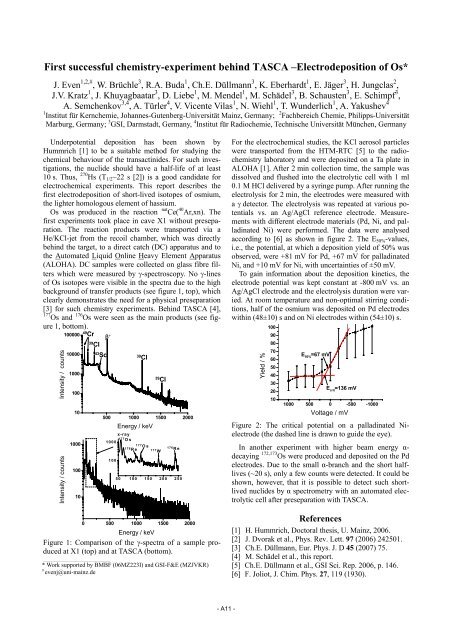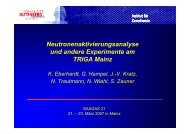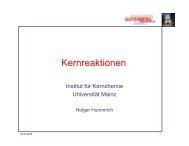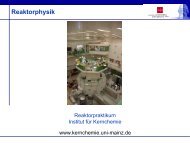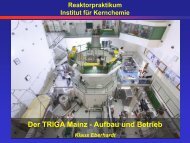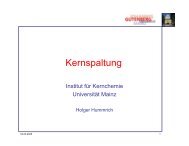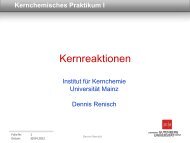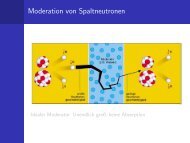jahresbericht 2007 - Institut für Kernchemie - Johannes Gutenberg ...
jahresbericht 2007 - Institut für Kernchemie - Johannes Gutenberg ...
jahresbericht 2007 - Institut für Kernchemie - Johannes Gutenberg ...
Create successful ePaper yourself
Turn your PDF publications into a flip-book with our unique Google optimized e-Paper software.
First successful chemistry-experiment behind TASCA –Electrodeposition of Os*<br />
J. Even 1,2,# , W. Brüchle 3 , R.A. Buda 1 , Ch.E. Düllmann 3 , K. Eberhardt 1 , E. Jäger 3 , H. Jungclas 2 ,<br />
J.V. Kratz 1 , J. Khuyagbaatar 3 , D. Liebe 1 , M. Mendel 1 , M. Schädel 3 , B. Schausten 3 , E. Schimpf 3 ,<br />
A. Semchenkov 3,4 , A. Türler 4 , V. Vicente Vilas 1 , N. Wiehl 1 , T. Wunderlich 1 , A. Yakushev 4<br />
1 <strong>Institut</strong> für <strong>Kernchemie</strong>, <strong>Johannes</strong>-<strong>Gutenberg</strong>-Universität Mainz, Germany; 2 Fachbereich Chemie, Philipps-Universität<br />
Marburg, Germany; 3 GSI, Darmstadt, Germany, 4 <strong>Institut</strong> für Radiochemie, Technische Universität München, Germany<br />
Underpotential deposition has been shown by<br />
Hummrich [1] to be a suitable method for studying the<br />
chemical behaviour of the transactinides. For such investigations,<br />
the nuclide should have a half-life of at least<br />
10 s. Thus, 270 Hs (T 1/2 ~22 s [2]) is a good candidate for<br />
electrochemical experiments. This report describes the<br />
first electrodeposition of short-lived isotopes of osmium,<br />
the lighter homologous element of hassium.<br />
Os was produced in the reaction nat Ce( 40 Ar,xn). The<br />
first experiments took place in cave X1 without preseparation.<br />
The reaction products were transported via a<br />
He/KCl-jet from the recoil chamber, which was directly<br />
behind the target, to a direct catch (DC) apparatus and to<br />
the Automated Liquid Online Heavy Element Apparatus<br />
(ALOHA). DC samples were collected on glass fibre filters<br />
which were measured by γ-spectroscopy. No γ-lines<br />
of Os isotopes were visible in the spectra due to the high<br />
background of transfer products (see figure 1, top), which<br />
clearly demonstrates the need for a physical preseparation<br />
[3] for such chemistry experiments. Behind TASCA [4],<br />
177 Os and 176 Os were seen as the main products (see figure<br />
1, bottom).<br />
Intensity / counts<br />
Intensity / counts<br />
49<br />
100000 Cr β +<br />
39<br />
Cl<br />
10000 43<br />
Sc<br />
1000<br />
100<br />
10<br />
1000<br />
100<br />
10<br />
39<br />
Cl<br />
39<br />
Cl<br />
500 1000 1500 2000<br />
Energy / keV<br />
x-ray<br />
177 Os<br />
1000<br />
177 Os<br />
176 Re W<br />
176 Re<br />
100<br />
50 100 150 200 250<br />
0 500 1000 1500 2000<br />
Energy / keV<br />
Figure 1: Comparison of the γ-spectra of a sample produced<br />
at X1 (top) and at TASCA (bottom).<br />
___________________________________________<br />
* Work supported by BMBF (06MZ223I) and GSI-F&E (MZJVKR)<br />
#<br />
evenj@uni-mainz.de<br />
For the electrochemical studies, the KCl aerosol particles<br />
were transported from the HTM-RTC [5] to the radiochemistry<br />
laboratory and were deposited on a Ta plate in<br />
ALOHA [1]. After 2 min collection time, the sample was<br />
dissolved and flushed into the electrolytic cell with 1 ml<br />
0.1 M HCl delivered by a syringe pump. After running the<br />
electrolysis for 2 min, the electrodes were measured with<br />
a γ detector. The electrolysis was repeated at various potentials<br />
vs. an Ag/AgCl reference electrode. Measurements<br />
with different electrode materials (Pd, Ni, and palladinated<br />
Ni) were performed. The data were analysed<br />
according to [6] as shown in figure 2. The E 50% -values,<br />
i.e., the potential, at which a deposition yield of 50% was<br />
observed, were +81 mV for Pd, +67 mV for palladinated<br />
Ni, and +10 mV for Ni, with uncertainties of ±50 mV.<br />
To gain information about the deposition kinetics, the<br />
electrode potential was kept constant at -800 mV vs. an<br />
Ag/AgCl electrode and the electrolysis duration were varied.<br />
At room temperature and non-optimal stirring conditions,<br />
half of the osmium was deposited on Pd electrodes<br />
within (48±10) s and on Ni electrodes within (54±10) s.<br />
Yield / %<br />
100<br />
90<br />
80<br />
70<br />
60<br />
50<br />
40<br />
30<br />
20<br />
10<br />
E 50%<br />
=67 mV<br />
E crit<br />
=136 mV<br />
1000 500 0 -500 -1000<br />
Voltage / mV<br />
Figure 2: The critical potential on a palladinated Nielectrode<br />
(the dashed line is drawn to guide the eye).<br />
In another experiment with higher beam energy α-<br />
decaying 172,173 Os were produced and deposited on the Pd<br />
electrodes. Due to the small α-branch and the short halflives<br />
(~20 s), only a few counts were detected. It could be<br />
shown, however, that it is possible to detect such shortlived<br />
nuclides by α spectrometry with an automated electrolytic<br />
cell after preseparation with TASCA.<br />
References<br />
[1] H. Hummrich, Doctoral thesis, U. Mainz, 2006.<br />
[2] J. Dvorak et al., Phys. Rev. Lett. 97 (2006) 242501.<br />
[3] Ch.E. Düllmann, Eur. Phys. J. D 45 (<strong>2007</strong>) 75.<br />
[4] M. Schädel et al., this report.<br />
[5] Ch.E. Düllmann et al., GSI Sci. Rep. 2006, p. 146.<br />
[6] F. Joliot, J. Chim. Phys. 27, 119 (1930).<br />
- A11 -


